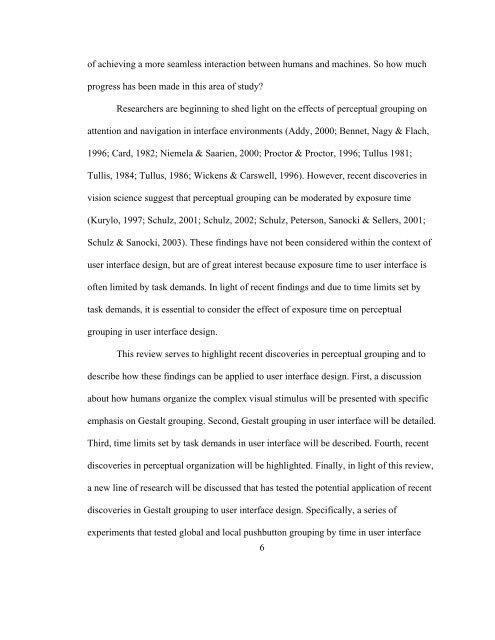The Use of Iambic Pentameter in the
The Use of Iambic Pentameter in the
The Use of Iambic Pentameter in the
You also want an ePaper? Increase the reach of your titles
YUMPU automatically turns print PDFs into web optimized ePapers that Google loves.
<strong>of</strong> achiev<strong>in</strong>g a more seamless <strong>in</strong>teraction between humans and mach<strong>in</strong>es. So how much<br />
progress has been made <strong>in</strong> this area <strong>of</strong> study?<br />
Researchers are beg<strong>in</strong>n<strong>in</strong>g to shed light on <strong>the</strong> effects <strong>of</strong> perceptual group<strong>in</strong>g on<br />
attention and navigation <strong>in</strong> <strong>in</strong>terface environments (Addy, 2000; Bennet, Nagy & Flach,<br />
1996; Card, 1982; Niemela & Saarien, 2000; Proctor & Proctor, 1996; Tullus 1981;<br />
Tullis, 1984; Tullus, 1986; Wickens & Carswell, 1996). However, recent discoveries <strong>in</strong><br />
vision science suggest that perceptual group<strong>in</strong>g can be moderated by exposure time<br />
(Kurylo, 1997; Schulz, 2001; Schulz, 2002; Schulz, Peterson, Sanocki & Sellers, 2001;<br />
Schulz & Sanocki, 2003). <strong>The</strong>se f<strong>in</strong>d<strong>in</strong>gs have not been considered with<strong>in</strong> <strong>the</strong> context <strong>of</strong><br />
user <strong>in</strong>terface design, but are <strong>of</strong> great <strong>in</strong>terest because exposure time to user <strong>in</strong>terface is<br />
<strong>of</strong>ten limited by task demands. In light <strong>of</strong> recent f<strong>in</strong>d<strong>in</strong>gs and due to time limits set by<br />
task demands, it is essential to consider <strong>the</strong> effect <strong>of</strong> exposure time on perceptual<br />
group<strong>in</strong>g <strong>in</strong> user <strong>in</strong>terface design.<br />
This review serves to highlight recent discoveries <strong>in</strong> perceptual group<strong>in</strong>g and to<br />
describe how <strong>the</strong>se f<strong>in</strong>d<strong>in</strong>gs can be applied to user <strong>in</strong>terface design. First, a discussion<br />
about how humans organize <strong>the</strong> complex visual stimulus will be presented with specific<br />
emphasis on Gestalt group<strong>in</strong>g. Second, Gestalt group<strong>in</strong>g <strong>in</strong> user <strong>in</strong>terface will be detailed.<br />
Third, time limits set by task demands <strong>in</strong> user <strong>in</strong>terface will be described. Fourth, recent<br />
discoveries <strong>in</strong> perceptual organization will be highlighted. F<strong>in</strong>ally, <strong>in</strong> light <strong>of</strong> this review,<br />
a new l<strong>in</strong>e <strong>of</strong> research will be discussed that has tested <strong>the</strong> potential application <strong>of</strong> recent<br />
discoveries <strong>in</strong> Gestalt group<strong>in</strong>g to user <strong>in</strong>terface design. Specifically, a series <strong>of</strong><br />
experiments that tested global and local pushbutton group<strong>in</strong>g by time <strong>in</strong> user <strong>in</strong>terface<br />
6

















